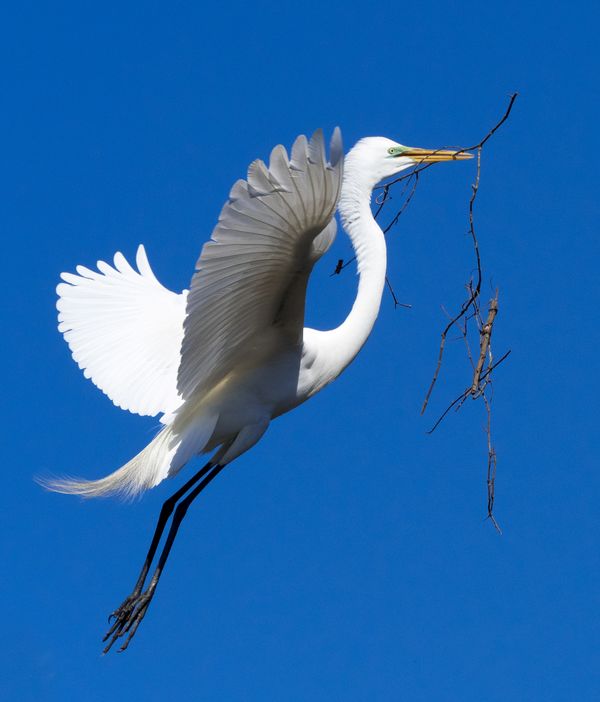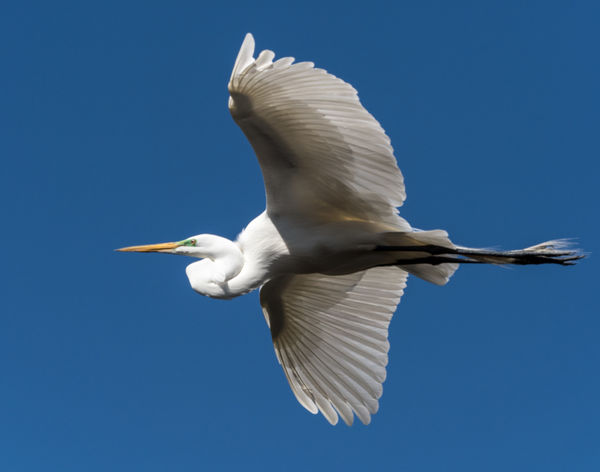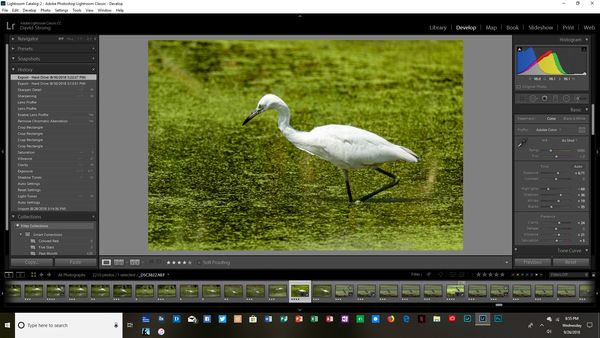Washed out wings
Sep 25, 2018 20:02:58 #
Sep 26, 2018 06:17:57 #
AzPicLady wrote:
Use spot metering and meter off the white bird. Then if the dark areas get too dark, you can perhaps bring them up a bit in PP.
Spot, AI-Servo, burst mode and a shutter speed to cover movement especially if you plan to catch them in flight.
Sep 26, 2018 07:25:42 #
billnikon
Loc: Pennsylvania/Ohio/Florida/Maui/Oregon/Vermont
Les Brown wrote:
Please, a bit of advice. I love shooting shore birds, both still and in flight. Many are snowy white. I shoot with a D7200 and a Nikon 200- 500 lens, that I love. But regardless of lens, I still have trouble capturing wing and feather texture without a white wash out. I try to keep the light behind me as much ss possible. I can do a good bit with PP, but more advice, sources, appreciated. Thanks in advance great UHHers.
If the light is behind you and delivers a steady souse of brightness, then, use you exposure compensation dial and dial down your exposures, say, -.7 to -1.3 to start. I use center weighted metering so I am metering just the bird. Keep in mind if you then want to track a darker bird, say a blue heron, you may have to go the other direction with your exposure compensation, say +.7 to +1.3 as a starting point. It is important to to keep in mind that as the bird changes direction and the sun is no longer behind you, this will also effect the exposure compensation you have currently dialed in. It becomes routine after a while and you will find yourself chimping less and less.
Sep 26, 2018 08:25:30 #
fetzler
Loc: North West PA
Here are some suggestions. 1. Shoot RAW files. 2. use exposure composition. usually -1/3 to -2/3 ev should work. 3. consider a pseudo HDR version. From the original exposure make 3 TIFF file : -1 ev. 0 ev and +1 ev. The resulting HDR can be great and with the right settings will look realistic.
Sep 26, 2018 08:39:55 #
Shooting in JPEG is never going to give you the control in PP. If you think you need JPEG for some reason (quick show and tell) then shoot in RAW and JPEG.
This photo was shot in RAW - PP in Lightroom and exported in JPEG. The metadata is: Spot Metered, ISO 400, 1/1000, f/5.9, Focal length 350mm with my Olympus 4/3rds camera. I focused on the bird in flight (spot metered) so I would expose for the bird, not the sky.
This photo was shot in RAW - PP in Lightroom and exported in JPEG. The metadata is: Spot Metered, ISO 400, 1/1000, f/5.9, Focal length 350mm with my Olympus 4/3rds camera. I focused on the bird in flight (spot metered) so I would expose for the bird, not the sky.
Sep 26, 2018 10:43:53 #
Sep 26, 2018 11:03:57 #
Sep 26, 2018 11:59:07 #
wrangler5
Loc: Missouri
On my mirrorless cameras I include the histogram in the viewfinder, and dial down exposure to keep the graph away from the far right end. Can't do that with DSLRs while shooting, but it looks like everybody is finally going mirrorless so it should be an option before long with all brands.
Sep 26, 2018 12:09:07 #
Why Not, press the assign button you have chosen and any exposure that you have dialed in will show up in your view finder, not to mention I have an exposure meter in my view finder. I can change exposure compensation, ISO, shutter speed, and aperture while looking through my view finder. You just have to know how to use the camera. Personally I don't see myself going to mirrorless any time soon. Remember it's the photographer that captures the shot, not the camera. The camera is only as good as the operator.......
wrangler5 wrote:
On my mirrorless cameras I include the histogram in the viewfinder, and dial down exposure to keep the graph away from the far right end. Can't do that with DSLRs while shooting, but it looks like everybody is finally going mirrorless so it should be an option before long with all brands.
Sep 26, 2018 16:10:11 #
I shoot with the 200-500 but you can't meter off of a dark area or the exposure will wash out the whites. I shoot egrets frequently and have all of the detail. Photoshop and light room cannot bring back the texture and detail if it doesn't exist. Try narrowing the field for metering and perhaps also work with EV values.
Good luck.
Good luck.
Sep 26, 2018 17:55:39 #
I live in a land of eagles. It is common to over expose the white head and tail when shooting them against the dark spruce forests. I set my camera to underexpose about one stop as soon as I head out if eagles are going to be the subject of the day.
...Cam
...Cam
Sep 26, 2018 19:39:10 #
Strodav
Loc: Houston, Tx
A lot of good advice in the replies especially about shooting raw. I'll add the D7200, like most dslrs, has a bracket function you might want to try. When shooting snowy egrets or a darker tri-colored Heron in bright sunlight, I set the shutter to CH (continuous High) and bracket 3 shots at +/-1 ev then pick the best one during post processing. The downsides to this method are you need to remember to reset it after using it and it does take a little practice to take 3 shots and only 3 shots, but I get a lot less shots with the white or black feathers saturated and irretrievable.
Sep 26, 2018 20:00:47 #
Unless the whites in a jpg are completely blown out, you can use curves in a PP program to bring out detail.
Sep 26, 2018 22:11:16 #
Strodav
Loc: Houston, Tx
Strodav wrote:
A lot of good advice in the replies especially abo... (show quote)
Sometimes the contrast range of the image is bigger than the camera can handle and you have to choose whether you want to save the highlights or shadows. You can see this in the histogram on the a LR screen shot of an egret below. The background and shadows are in the center to left of the histogram and the small bump on the right side is the egret. The sun is above and is blowing out the top of the head and back feathers. I should have taken another shot under exposed by a stop even two to bring the highlights in sacrificing the shadows.
Sep 26, 2018 22:19:02 #
I wonder if you ever use the + bracket in this scenario. I would probably shoot normal, then minus 1, minus 2. Really though, I just shoot one shot with a minus exposure. When the birds are flying around I don't want to wait for bracketed shots.
...Cam
...Cam
Strodav wrote:
A lot of good advice in the replies especially abo... (show quote)
If you want to reply, then register here. Registration is free and your account is created instantly, so you can post right away.








